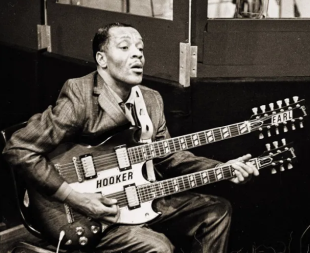
Junior Wells was an American singer, harmonica player, and recording artist. He is best known for his signature song "Messin' with the Kid" and his 1965 album Hoodoo Man Blues, described by the critic Bill Dahl as "one of the truly classic blues albums of the 1960s". Wells himself categorized his music as rhythm and blues.

Theodore Roosevelt "Hound Dog" Taylor was an American Chicago blues guitarist and singer.

Earl Zebedee Hooker was a Chicago blues guitarist known for his slide guitar playing. Considered a "musician's musician", he performed with blues artists such as Sonny Boy Williamson II, Junior Wells, and John Lee Hooker and fronted his own bands. An early player of the electric guitar, Hooker was influenced by the modern urban styles of T-Bone Walker and Robert Nighthawk. He recorded several singles and albums as a bandleader and with other well-known artists. His "Blue Guitar", a slide guitar instrumental single, was popular in the Chicago area and was later overdubbed with vocals by Muddy Waters as "You Shook Me".

Tony Furtado is an American singer-songwriter, banjoist, and guitarist.

Derek Trucks is an American guitarist, songwriter, and founder of The Derek Trucks Band. He became an official member of The Allman Brothers Band in 1999. In 2010, he formed the Tedeschi Trucks Band with his wife, blues singer/guitarist Susan Tedeschi. His musical style encompasses several genres and he has twice appeared on Rolling Stone's list of 100 Greatest Guitarists of All Time. He is the nephew of the late Butch Trucks, drummer for the Allman Brothers.

Clide Vernon "Sonny" Landreth is an American blues musician from southwest Louisiana who is especially known as a slide guitar player. He was born in Canton, Mississippi, and settled in Lafayette, Louisiana. He lives in Breaux Bridge, Louisiana.

Carey Bell Harrington was an American blues musician who played harmonica in the Chicago blues style. Bell played harmonica and bass guitar for other blues musicians from the late 1950s to the early 1970s before embarking on a solo career. Besides his own albums, he recorded as an accompanist or duo artist with Earl Hooker, Robert Nighthawk, Lowell Fulson, Eddie Taylor, Louisiana Red and Jimmy Dawkins and was a frequent partner with his son, the guitarist Lurrie Bell. Blues Revue called Bell "one of Chicago's finest harpists." The Chicago Tribune said Bell was "a terrific talent in the tradition of Sonny Boy Williamson and Little Walter." In 2023, he was inducted in the Blues Hall of Fame.
"One Way Out" is a blues song that was recorded in the early 1960s by both Sonny Boy Williamson II and Elmore James. A reworking of the song by G. L. Crockett, titled "It's a Man Down Here", appeared on the Billboard record charts in 1965. In 1971, the Allman Brothers Band recorded an updated live version of the song, which was included on their popular Eat a Peach album (1972).

Hoodoo Man Blues is the debut album of blues vocalist and harmonica player Junior Wells, performing with the Junior Wells' Chicago Blues Band, an early collaboration with guitarist Buddy Guy. Released on LP by Delmark Records in November 1965, the album has been subsequently reissued on CD and LP by Delmark and Analogue Productions.
"Early in the Morning" is a blues song that was recorded by Sonny Boy Williamson I in 1937. Identified as one of his most successful and influential tunes, it was inspired by earlier blues songs. "Early in the Morning" has been recorded by various musicians, including Junior Wells, who made it part of his repertoire.

Roots is an album by blues guitarist and singer Johnny Winter. His first studio album in seven years, it was released by Megaforce Records on September 27, 2011.

Too Wet to Plow is an album by the American musician Johnny Shines, released in 1977.

Doo Dad is an album by the American roots rock musician Webb Wilder, released in 1991.

Outward Bound is an album by the American musician Sonny Landreth, released in 1992. Landreth supported the album by playing the Montreal International Jazz Festival.

Eldorado Cadillac is an album by the American musician Billy Boy Arnold, released in 1995. It was the second album of his 1990s comeback. Arnold considered his two Alligator Records albums to be the best of his career. The album won a National Association of Independent Record Distributors award for best blues album.

That's When I Know is an album by the American musician Eddie C. Campbell, released in 1994. It marked Campbell's return to the United States after spending more than a decade in Europe. Campbell supported the album with a North American tour. The title track was nominated for a W. C. Handy Award.

Who Stole the Hot Sauce? is an album by the American band Chubby Carrier and the Bayou Swamp Band, released in 1996. The band supported the album with a North American tour that included several festival appearances. The album was a success on blues radio stations. The title track became one of Carrier's most popular songs.

The Real Deal is an album by the American musician John Primer, released in 1995. Primer supported the album with a North American tour. He subsequently named his backing band the Real Deal. The Real Deal was nominated for a W. C. Handy Award for best "Traditional Blues Album".

Ramblin' Mind is an album by the American musician Big Bill Morganfield, released in 2001. Morganfield supported the album with a North American tour.

You Need to Live a Little is an album by the American musician Larry Garner, released in 1995. Garner's contract with Gitanes/Verve Records allowed him to quit his day job in order to promote the album. He supported it with United Kingdom and North American tours.


















